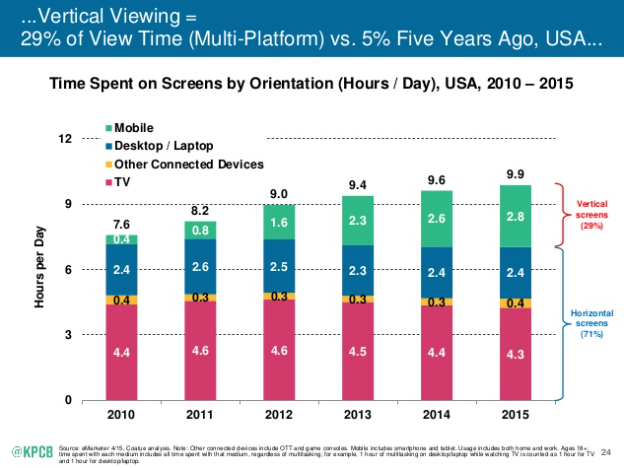Each year, analyst Mary Meeker of the venture capital firm Kleiner Perkins Caufield & Byers (KPCB) unveils her Internet Trends Report at Code Conference, recapping key trends and taking a look at what’s to come for the World Wide Web. Her 2015 Internet Trends Report is 197 slides-worth of valuable data that provides a lens into what’s happening now online. Here are eight key takeaways for communications professionals:
The future of social advertising is bright.
Forget the era of simple banner ads. New advertising formats will continue to introduce fresh ways users can interact with brand content. For example, with Pinterest Cinematic ads, the video moves as the user scrolls. Facebook Carousel ads allow users to scroll to browse multiple images and links. Google Inventory ads will show products available in stores nearby, allowing for an omnichannel approach to advertising. Buy buttons – introduced on some social sites already – will continue to grow in popularity and functionality. These interactive options will be useful for brands looking to continue to connect with consumers along the marketing funnel.
We’re watching more vertical video than ever before.
With mobile usage growing, vertical viewing has increased. Desktops, laptops and TVs are all more conducive to streaming a horizontal image, but iPhones and Androids default to the vertical video. Why does this matter? The format of an image or video really does have an impact on viewability. Full-screen vertical video ads on Snapchat have nine times the completion rate than horizontal video ads do. When planning the creation of a video, understanding where the video will be placed will have huge implications.
Messaging apps are taking over.
Six out of the top 10 most used apps globally are messaging apps. In the future, these messaging apps may become more central communication hubs. For example, a consumer could order and pay for an item via Facebook Messenger and the store could update the customer on order status for truly context-driven communication. Brands will be able to streamline e-commerce and customer service in a way that is currently unavailable.
Snapchat isn’t going anywhere.
If Snapchat Stories or Snapchat Discover wasn’t enough to make you #TeamSnapchat, you may want to hop on the bandwagon. With 100,000,000 daily active users, the photo-messaging app is a mainstay. There are two billion Snapchat story views per day.
Pinterest isn’t just for planning meals and weddings.
While Pinterest has seen continued content growth across the board, there’s been a surge in non-core categories (i.e., pins other than recipes, outfits and wedding planning). Car and motorcycle pins have increased by 118 percent this year and men’s fashion pins have increased by 96 percent year-over-year. This shows a huge opportunity for male-targeted brands that previously have shied away from Pinterest.
Video views surge on Facebook.
If you aren’t creating video content for Facebook yet, you may want to begin now. Facebook Video views have increased four-fold over the past six months to about 4 billion video views per day with 50 percent of daily active users on Facebook watching one or more video on the platform each day. Fifty-three percent of these views come from shares. Creating relevant content that prompts users to share will be important to increase viewability. And since 75 percent of videos are viewed on mobile, ensuring videos are clear, crisp and mobile-friendly is essential.
Millennials (predictably) love smartphones.
Eighty-seven percent of millennials said that, “my smartphone never leaves my side, night or day.” As a millennial, I don’t know whether to be proud or ashamed that I’m within this 87 percent. A majority (60 percent) of millennials also say that, “In the next five years, I believe everything will be done on mobile devices.” A mobile-first mindset will be essential for brands as millennials continue to enter the workforce and achieve greater spending power.
Online platforms pave the way for e-commerce.
In 2014, e-commerce was 9 percent of retail sales versus less than 1 percent in 1998. Online platforms are enabling growth in product and service categories. Product e-commerce has grown 26 percent over last year and the service commerce sector has seen rapid growth. This rapid growth is exemplified by Airbnb, a website for people to rent out lodging. Since 2008, the year Airbnb launched, there have been 35 million total guests staying in housing secured through Airbnb, with 25 million of these guests from last year alone.
Read the full report here. What trend are you most excited about?

